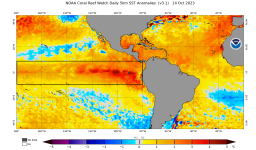Or...
Earth’s Diminishing Magnetic Dipole Moment is Driving Global Carbon Dioxide Levels and Global WarmingDavid A. E. Vares1,2, Michael A. Persinger1,2,3
1Human Studies, Laurentian University, Sudbury, Canada.
2Behavioural Neuroscience Programs, Laurentian University, Sudbury, Canada.
3Biomolecular Sciences, Laurentian University, Sudbury, Canada.
DOI: 10.4236/ijg.2015.68068 PDF HTML XML 5,761 Downloads 9,409 Views Citations
Abstract
Although there are powerful models that couple human activity with elevated atmospheric carbon dioxide levels and global warming, the relationships are still based upon correlations rather than causation. Consequently, there is always the probability of a third factor that produces both. Analyses of the diminishing magnetic dipole moment of the earth and the increased carbon dioxide levels and global temperature within the last 40 years revealed correlations of -0.99 and -0.90, respectively. This powerful association has been reported by other researchers. Why it has been ignored by the scientific community is not clear. The sources of the shift in average geomagnetic (magnetic dipole) intensity have not been identified but these relatively rapid decreases and increases have occurred historically with onsets of periods of warming and cooling, including glacier formation. If the long-time quasi-periodicity of the earth’s magnetic dipole moment is coupled to alterations in solar activity as the system moves around the galactic center, then attribution of elevated carbon dioxide-temperature to human sources rather than actual etiologies can be counterproductive to adaptation.
Earth’s Diminishing Magnetic Dipole Moment is Driving Global Carbon Dioxide Levels and Global WarmingDavid A. E. Vares1,2, Michael A. Persinger1,2,3
1Human Studies, Laurentian University, Sudbury, Canada.
2Behavioural Neuroscience Programs, Laurentian University, Sudbury, Canada.
3Biomolecular Sciences, Laurentian University, Sudbury, Canada.
DOI: 10.4236/ijg.2015.68068 PDF HTML XML 5,761 Downloads 9,409 Views Citations
Abstract
Although there are powerful models that couple human activity with elevated atmospheric carbon dioxide levels and global warming, the relationships are still based upon correlations rather than causation. Consequently, there is always the probability of a third factor that produces both. Analyses of the diminishing magnetic dipole moment of the earth and the increased carbon dioxide levels and global temperature within the last 40 years revealed correlations of -0.99 and -0.90, respectively. This powerful association has been reported by other researchers. Why it has been ignored by the scientific community is not clear. The sources of the shift in average geomagnetic (magnetic dipole) intensity have not been identified but these relatively rapid decreases and increases have occurred historically with onsets of periods of warming and cooling, including glacier formation. If the long-time quasi-periodicity of the earth’s magnetic dipole moment is coupled to alterations in solar activity as the system moves around the galactic center, then attribution of elevated carbon dioxide-temperature to human sources rather than actual etiologies can be counterproductive to adaptation.










